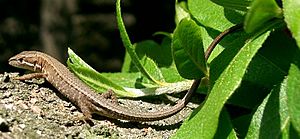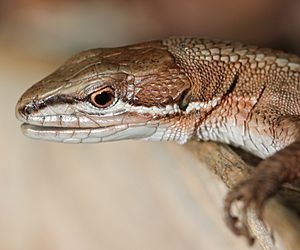Japanese grass lizard facts for kids
Quick facts for kids Japanese grass lizard |
|
|---|---|
 |
|
| Conservation status | |
| Scientific classification |
The Takydromus tachydromoides, also known as the Japanese grass lizard, is a common lizard found across Japan. Its Japanese name is 'kanahebi' (カナヘビ). Even though 'hebi' means 'snake' in Japanese, this creature is definitely a lizard, not a snake!
Contents
Discovering the Japanese Grass Lizard
The Japanese grass lizard is one of three main lizards you can find on Japan's four largest islands. It's a unique reptile with some interesting features.
Other Lizards of Japan
Besides the Japanese grass lizard, you might also spot two other types of lizards in Japan:
- The Japanese gekko (Gekko japonicus). This gecko is sometimes called Schlegel's Japanese gekko.
- The Japanese five-lined skink (Plestiodon latiscutatus). This skink only shows its five distinct lines when it's young. As it grows up, these lines fade away.
What Does It Look Like?
The Japanese grass lizard is quite slender. It usually grows to be about 18 to 25 centimeters (about 7 to 10 inches) long. A big part of its length is its tail, which makes up more than two-thirds of its total body size! Its skin often looks a bit dry to the touch.
Where Do Japanese Grass Lizards Live?
These lizards love to live in open, sunny places. You can often find them in grassland areas. Sometimes, they even make their homes on rooftops!
Sunbathing for Warmth
Like many reptiles, Japanese grass lizards are cold-blooded. This means they need to use the sun to control their body temperature. They often bask in sunny spots to warm up. This helps them stay active and healthy.
What Do Japanese Grass Lizards Eat?
Japanese grass lizards are insectivores, which means they primarily eat insects. Their diet mainly consists of small creatures they can catch.
Life Cycle and Reproduction
The Japanese grass lizard has a simple but effective way of reproducing.
Laying Eggs
Female Japanese grass lizards lay white eggs. These eggs are usually hidden in safe spots in their habitat.
Caring for Young
Unlike some other animals, Japanese grass lizards do not protect their eggs once they are laid. The young lizards hatch from the eggs and are then on their own to find food and survive.



